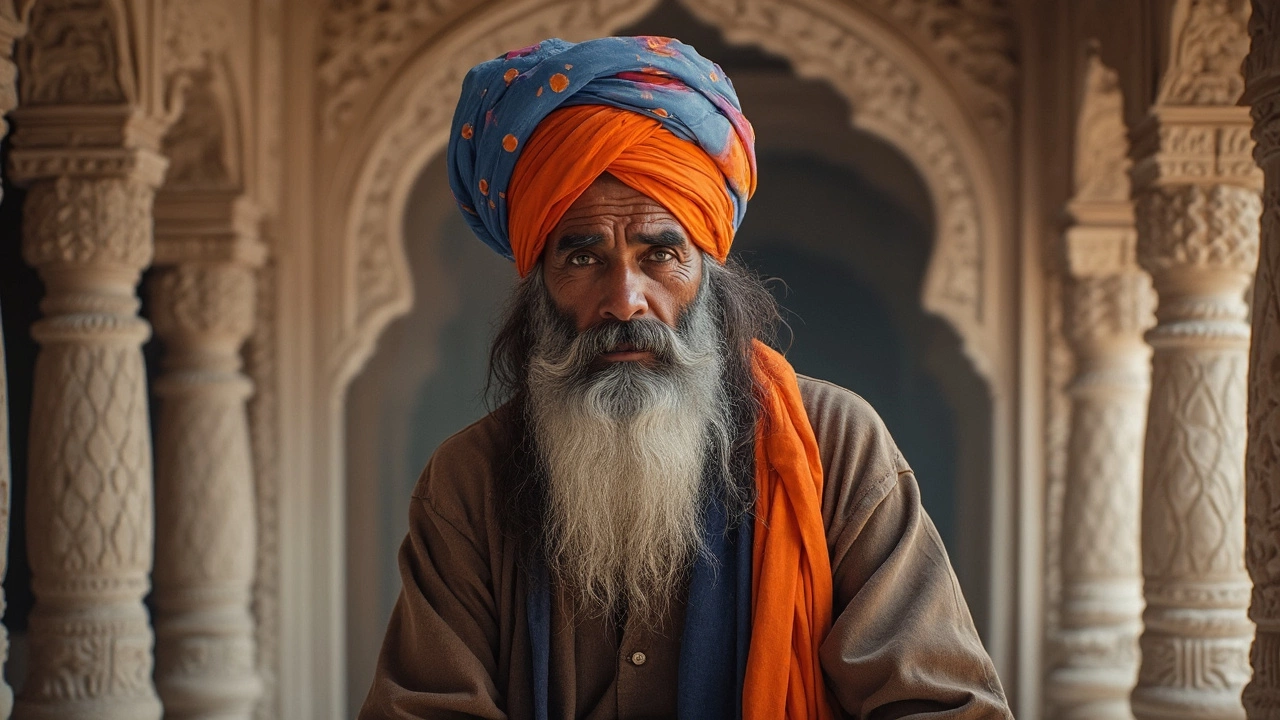
Ever wondered why Sikhs never cut their hair? Well, it's not just about style or following a trend. It's actually one of the most significant practices tied to Sikh identity. This tradition, known as Kesh, is a symbol of devotion and respect for how nature intended us to be.
The roots of this practice go back to the 17th century when Guru Gobind Singh, the tenth Sikh Guru, laid down the Five Ks as the articles of faith for Sikhs. Kesh, being one of them, is more than just a physical trait. It's a symbol of spirituality, acceptance, and self-discipline.
But it doesn't stop there. Maintaining uncut hair, which is often wrapped under a turban, serves as a reminder of the commitment Sikhs make towards their faith and culture. It's a daily practice that ties them to their community and past, echoing a tradition that enriches their spiritual lives.
- The Significance of Kesh in Sikhism
- The Historical Roots of Sikh Practices
- Symbolism and Spirituality
- Daily Care of Uncut Hair
- Comparison with Other Indian Traditions
- Cultural Challenges and Modern Perspectives
The Significance of Kesh in Sikhism
The practice of keeping hair uncut, known as Kesh, holds a special place in Sikhism. It’s not just about following a rule; it's deeply rooted in spiritual faith and Sikh identity. For Sikhs, letting their hair grow naturally is a way of honoring the perfection of God's creation.
Back in the day, Guru Gobind Singh, the tenth Guru, set forth the Five Ks as a way to visually and spiritually unify all Sikhs. Kesh was included because it symbolizes acceptance of God’s will. By wearing their hair unshorn, Sikhs respect the idea that everything given by nature is perfect as it is. It's like living in harmony with oneself and the world.
The significance goes beyond appearance. It also represents strength and courage. Many Sikhs take pride in it because it serves as a humble reminder of their roots and responsibilities. Plus, during the times when Sikh warriors had to defend their rights and beliefs, they wore their long hair tied up as a practical way to be battle-ready at any moment.
Keeping hair uncut isn't just a private act. It's a public statement that connects Sikhs to their community. It fosters a sense of unity and continuity, tying individuals to their ancestors and the larger Sikh history. It’s a simple but powerful symbol that speaks volumes about their commitment to their faith and principles.
This practice might seem challenging in today's modern world where stereotypes exist, but for Sikhs, it's a cherished part of who they are. They proudly wear their uncut hair as a badge of honor, celebrating their cultural heritage while embracing and respecting the divine design.
The Historical Roots of Sikh Practices
Sikh practices, especially the significance of the hair, date way back to the founding days of Sikhism in the 15th century. This was a time when Guru Nanak, the first Sikh Guru, laid the foundational principles that emphasized devotion, equality, and compassion. However, the specific practice of maintaining uncut hair, or Kesh, is closely associated with Guru Gobind Singh, the tenth Sikh Guru.
In 1699, Guru Gobind Singh established the Khalsa, a community of initiated Sikhs bound by a code of conduct. It was during the Vaisakhi festival that year that he introduced the Five Ks, five articles of faith that define Sikh identity. These articles include Kesh (uncut hair), Kara (a metal bracelet), Kanga (a wooden comb), Kachera (special undergarments), and Kirpan (a ceremonial sword).
The idea was not just about physical appearance but a deeper connection to spirituality and discipline. Uncut hair was seen as a symbol of living in harmony with God's will and a reminder of one's faith and duty as a Sikh.
Sikhism taught that by living with natural hair as given by God, an individual would daily affirm their connection with the divine. Over time, this practice also became vital in fostering a sense of unity and identity among Sikhs, particularly during tumultuous periods in history when they faced oppression and persecution.
These practices have helped Sikhs maintain a distinct identity amidst diverse cultural landscapes, including the vast cultural tapestry of India. By adhering to these traditions, Sikhs not only express their faith but also their values and resilience in the face of challenges.
Symbolism and Spirituality
When it comes to Sikhism, the symbolism tied to just about everything is deeply embedded in spirituality. Uncut hair, or Kesh, plays a massive role in this. For Sikhs, leaving your hair uncut is not just about the past or tradition; it embodies surrender to God's will and accepting our natural form as divine.
One of the fundamental ideas here is to maintain the God-given form. By not altering it, Sikhs show their acceptance of God's creation and live in harmony with their natural selves. This distinctive practice also sets them apart, not just physically but spiritually.
As Guru Nanak, the founder of Sikhism, once said,
"Let your actions define who you are, not your looks."This quote highlights that while Kesh is a visible commitment, it's the action and faith that truly define a Sikh.
Uncut hair also represents strength and spirituality, connecting Sikhs to their Gurus. Many Sikhs experience a heightened sense of identity and pride in maintaining this tradition, emphasizing their deep connection to their faith.
This conscious effort to keep one's hair uncut helps in strengthening self-discipline and patience. Each day, when Sikhs tie their hair, they are reminded of their commitment to their spiritual journey. This personal routine serves as meditation, reinforcing their beliefs and anchoring them to their heritage and community.
In modern times, some Sikhs may face challenges maintaining this practice, especially in diverse and varying cultural environments. Yet, the significance of the symbolism and spiritual grounding in Kesh continues to offer guidance and strength to many in the community, making it a cherished part of Sikhism.

Daily Care of Uncut Hair
Taking care of uncut hair is not just about letting it grow wild. Instead, it's a routine that requires dedication and respect, as emphasized in Sikhism. For many Sikhs, this is an everyday ritual that signifies a spiritual discipline rooted in tradition.
So, how do Sikhs actually manage their hair? One of the essential practices is combing with a specific wooden comb called a Kangha. This doesn't just untangle knots but helps keep the hair clean and symbolizes daily tidiness and discipline. The Kangha is small enough to be worn in the hair or kept tucked in the turban.
Speaking of turbans, you might have noticed many Sikhs wearing them. Turbans not only serve as a marker of identity but also protect the uncut hair from dirt and pollution. Wrapping the turban, called 'dastar bandhi,' is an art in itself. It takes practice to perfect the skill of wrapping it neatly and securely over the hair bun.
Daily hair care tips often include washing the hair frequently to maintain hygiene, especially given the length many followers of Sikhism aim to keep. Natural oils or herbal treatments are sometimes used to ensure that the hair stays healthy and strong, supporting the idea of taking care of what nature has provided.
Let's not forget the importance of family in these practices. Many Sikhs learn these routines from parents and grandparents, passing down techniques and tools like specific oils or remedies that have been used for generations.
By nurturing their uncut hair, Sikhs aren't just following a cultural practice. They're honoring a deeper spiritual connection that says a lot without saying a word. It's an everyday commitment to living their beliefs.
Comparison with Other Indian Traditions
India is a land of diverse cultures and traditions, each offering a unique perspective on life. While the practice of keeping hair uncut is paramount in Sikhism, it's interesting to see how different traditions within India view hair and its significance.
Take, for instance, Hindu ascetics like the Sadhus and Gurus who often maintain long hair and beards as a sign of renunciation and spiritual focus. For them, uncut hair symbolizes a natural state of being, free from worldly attachments. In this sense, there's a parallel with Sikh teachings, where uncut hair signifies respect for God's creation.
Meanwhile, in southern India, it's common for followers of the Ayyappa tradition to refrain from cutting their hair during the pilgrimage season as a mark of devotion and discipline. This temporary abstention echoes the permanent commitment seen in Sikhism.
Another intriguing comparison is found with Jain monks who, in a stark contrast, practice a ritual of plucking hair as a form of non-attachment and penance. It points to the varied interpretations of spirituality through hair practices across Indian religions.
Each tradition reflects its unique way of honoring beliefs about the body, spirituality, and identity. Through hair traditions, these cultural practices showcase the rich tapestry of Indian religious life, offering multiple pathways to express deep-seated values and principles.
Cultural Challenges and Modern Perspectives
In today's world, Sikhism faces a number of cultural challenges, especially as younger generations interact more with global communities. One of the biggies is balancing traditional practices with modern life demands. In places where Sikhs are minorities, such as in Western countries, discrimination or misunderstanding can create pressure to conform to mainstream looks, including cutting hair.
For many young Sikhs, fitting in at school or work while staying true to their roots is a juggling act. It's tough when your peers don't share or understand why you're committed to a seemingly old-fashioned tradition like maintaining long hair. Nonetheless, many Sikhs wear their uncut hair and turbans as badges of pride, representing resilience and identity.
Technology and social media are also changing the conversation. Online platforms now offer places where Sikhs can share experiences, educate others, and find solidarity. This community support is vital for cultural preservation and fostering understanding among diverse global populations.
On an interesting note, there's been a rise in Sikh fashion influencers and entrepreneurs who are embedding traditional elements into modern clothing, making it stylish to embrace one's heritage while also appealing to the broader fashion scene. They've shown that being fashionable and holding on to one's traditions aren't mutually exclusive.
Moreover, community initiatives are on the rise, emphasizing the significance of Kesh through teachings, workshops, and discussions. These efforts encourage open dialogue about the symbolism of hair in Sikhism and its evolving place in today's society. By raising awareness and sharing knowledge, they aim to dispel myths and promote a more inclusive understanding of this integral Sikh practice.



